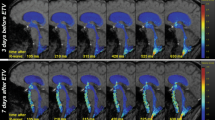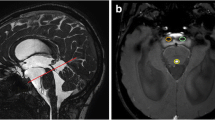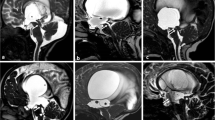Abstract
Objectives
To investigate the detectability of CSF flow alterations in the ventricular system of patients with hydrocephalus using time-resolved 3D MR velocity mapping.
Methods
MR velocity mapping was performed in 21 consecutive hydrocephalus patients and 21 age-matched volunteers using a 3D phase-contrast (PC) sequence. Velocity vectors and particle path lines were calculated for visualisation of flow dynamics. CSF flow was classified as “hypomotile flow” if it showed attenuated dynamics and as “hypermotile flow” if it showed increased dynamics compared with volunteers. Diagnostic efficacy was compared with routine 2D cine PC-MRI.
Results
Seven patients showed hypomotile CSF flow: six had non-communicating hydrocephalus due to aqueductal stenosis. One showed oscillating flow between the lateral ventricles after craniotomy for intracranial haemorrhage. Seven patients showed normal flow: six had hydrocephalus ex vacuo due to brain atrophy. One patient who underwent ventriculostomy 10 years ago showed a flow path through the opening. Seven patients showed hypermotile flow: three had normal pressure hydrocephalus, three had dementia, and in one the diagnosis remained unclear. The diagnostic efficacy of velocity mapping was significantly higher except for that of aqueductal stenosis.
Conclusions
Our approach may be useful for diagnosis, therapy planning, and follow-up of different kinds of hydrocephalus.
Key Points
• Velocity-mapping provides additional information about CSF flow compared to 2D phase-contrast MRI
• Ventricular CSF flow of hydrocephalus patients and volunteers shows complex 3D dynamics
• This technique may be useful for the management of patients with hydrocephalus
• The pathophysiological basis of CSF flow dysfunction may be better understood





Similar content being viewed by others
References
Rekate HL (2008) The definition and classification of hydrocephalus: a personal recommendation to stimulate debate. Cerebrospinal Fluid Res 5:2
Johanson CE, Duncan JA 3rd, Klinge PM, Brinker T, Stopa EG, Silverberg GD (2008) Multiplicity of cerebrospinal fluid functions: New challenges in health and disease. Cerebrospinal Fluid Res 5:10
Moran PR, Moran RA, Karstaedt N (1985) Verification and evaluation of internal flow and motion. True magnetic resonance imaging by the phase gradient modulation method. Radiology 154:433–441
Wedeen VJ, Rosen BR, Chesler D, Brady TJ (1985) MR velocity imaging by phase display. J Comput Assist Tomogr 9:530–536
Edelman RR, Wedeen VJ, Davis KR, Widder D, Hahn P, Shoukimas G, Brady TJ (1986) Multiphasic MR imaging: a new method for direct imaging of pulsatile CSF flow. Radiology 161:779–783
Enzmann DR, Pelc NJ (1991) Normal flow patterns of intracranial and spinal cerebrospinal fluid defined with phase-contrast cine MR imaging. Radiology 178:467–474
Ridgway JP, Turnbull LW, Smith MA (1987) Demonstration of pulsatile cerebrospinal-fluid flow using magnetic resonance phase imaging. Br J Radiol 60:423–427
Thomsen C, Stahlberg F, Stubgaard M, Nordell B (1990) Fourier analysis of cerebrospinal fluid flow velocities: MR imaging study. The Scandinavian Flow Group. Radiology 177:659–665
Bradley WG Jr (1992) Magnetic resonance imaging in the evaluation of cerebrospinal fluid flow abnormalities. Magn Reson Q 8:169–196
Bradley WG Jr, Scalzo D, Queralt J, Nitz WN, Atkinson DJ, Wong P (1996) Normal-pressure hydrocephalus: evaluation with cerebrospinal fluid flow measurements at MR imaging. Radiology 198:523–529
Kim DS, Choi JU, Huh R, Yun PH, Kim DI (1999) Quantitative assessment of cerebrospinal fluid hydrodynamics using a phase-contrast cine MR image in hydrocephalus. Childs Nerv Syst 15:461–467
Mase M, Yamada K, Banno T, Miyachi T, Ohara S, Matsumoto T (1998) Quantitative analysis of CSF flow dynamics using MRI in normal pressure hydrocephalus. Acta Neurochir Suppl 71:350–353
Abbey P, Singh P, Khandelwal N, Mukherjee KK (2009) Shunt surgery effects on cerebrospinal fluid flow across the aqueduct of Sylvius in patients with communicating hydrocephalus. J Clin Neurosci 16:514–518
Baledent O, Fin L, Khuoy L, Ambarki K, Gauvin AC, Gondry-Jouet C, Meyer ME (2006) Brain hydrodynamics study by phase-contrast magnetic resonance imaging and transcranial color doppler. J Magn Reson Imaging 24:995–1004
Bargallo N, Olondo L, Garcia AI, Capurro S, Caral L, Rumia J (2005) Functional analysis of third ventriculostomy patency by quantification of CSF stroke volume by using cine phase-contrast MR imaging. AJNR Am J Neuroradiol 26:2514–2521
de Marco G, Idy-Peretti I, Didon-Poncelet A, Baledent O, Onen F, Feugeas MC (2004) Intracranial fluid dynamics in normal and hydrocephalic states: systems analysis with phase-contrast magnetic resonance imaging. J Comput Assist Tomogr 28:247–254
Zhu DC, Xenos M, Linninger AA, Penn RD (2006) Dynamics of lateral ventricle and cerebrospinal fluid in normal and hydrocephalic brains. J Magn Reson Imaging 24:756–770
Bogren HG, Buonocore MH (1999) 4D magnetic resonance velocity mapping of blood flow patterns in the aorta in young vs. elderly normal subjects. J Magn Reson Imaging 10:861–869
Bammer R, Hope TA, Aksoy M, Alley MT (2007) Time-resolved 3D quantitative flow MRI of the major intracranial vessels: initial experience and comparative evaluation at 1.5 T and 3.0 T in combination with parallel imaging. Magn Reson Med 57:127–140
Hope TA, Markl M, Wigstrom L, Alley MT, Miller DC, Herfkens RJ (2007) Comparison of flow patterns in ascending aortic aneurysms and volunteers using four-dimensional magnetic resonance velocity mapping. J Magn Reson Imaging 26:1471–1479
Markl M, Draney MT, Hope MD, Levin JM, Chan FP, Alley MT, Pelc NJ, Herfkens RJ (2004) Time-resolved 3-dimensional velocity mapping in the thoracic aorta: visualization of 3-directional blood flow patterns in healthy volunteers and patients. J Comput Assist Tomogr 28:459–468
Wetzel S, Meckel S, Frydrychowicz A, Bonati L, Radue EW, Scheffler K, Hennig J, Markl M (2007) In vivo assessment and visualization of intracranial arterial hemodynamics with flow-sensitized 4D MR imaging at 3 T. AJNR Am J Neuroradiol 28:433–438
Frydrychowicz A, Winterer JT, Zaitsev M, Jung B, Hennig J, Langer M, Markl M (2007) Visualization of iliac and proximal femoral artery hemodynamics using time-resolved 3D phase contrast MRI at 3 T. J Magn Reson Imaging 25:1085–1092
Stadlbauer A, Salomonowitz E, van der Riet W, Buchfelder M, Ganslandt O (2010) Insight into the patterns of cerebrospinal fluid flow in the human ventricular system using MR velocity mapping. NeuroImage 51:42–52
Evans W (1942) An encephalographic ratio for estimating ventricular enlargement and cerebral atrophy. Arch Neurol Psychiatry 47:931–937
Ambarki K, Israelsson H, Wahlin A, Birgander R, Eklund A, Malm J (2010) Brain ventricular size in healthy elderly: comparison between Evans index and volume measurement. Neurosurgery 67:94–99
Sunshine JH, Applegate KE (2004) Technology assessment for radiologists. Radiology 230:309–314
Algin O, Hakyemez B, Gokalp G, Korfali E, Parlak M (2009) Phase-contrast cine MRI versus MR cisternography on the evaluation of the communication between intraventricular arachnoid cysts and neighbouring cerebrospinal fluid spaces. Neuroradiology 51:305–312
Chiang WW, Takoudis CG, Lee SH, Weis-McNulty A, Glick R, Alperin N (2009) Relationship between ventricular morphology and aqueductal cerebrospinal fluid flow in healthy and communicating hydrocephalus. Invest Radiol 44:192–199
Stivaros SM, Jackson A (2007) Changing concepts of cerebrospinal fluid hydrodynamics: role of phase-contrast magnetic resonance imaging and implications for cerebral microvascular disease. Neurotherapeutics 4:511–522
Yildiz H, Yazici Z, Hakyemez B, Erdogan C, Parlak M (2006) Evaluation of CSF flow patterns of posterior fossa cystic malformations using CSF flow MR imaging. Neuroradiology 48:595–605
Algin O, Hakyemez B, Parlak M (2010) The efficiency of PC-MRI in diagnosis of normal pressure hydrocephalus and prediction of shunt response. Acad Radiol 17:181–187
Kilner PJ, Yang GZ, Wilkes AJ, Mohiaddin RH, Firmin DN, Yacoub MH (2000) Asymmetric redirection of flow through the heart. Nature 404:759–761
Toger J, Carlsson M, Soderlind G, Arheden H, Heiberg E (2011) Volume tracking: a new method for quantitative assessment and visualization of intracardiac blood flow from three-dimensional, time-resolved, three-component magnetic resonance velocity mapping. BMC Med Imaging 11:10
Markl M, Kilner PJ, Ebbers T (2011) Comprehensive 4D velocity mapping of the heart and great vessels by cardiovascular magnetic resonance. J Cardiovasc Magn Reson 13:7
Muller-Eschner M, Rengier F, Partovi S, Unterhinninghofen R, Bockler D, Ley S, von Tengg-Kobligk H (2011) Tridirectional phase-contrast magnetic resonance velocity mapping depicts severe hemodynamic alterations in a patient with aortic dissection type Stanford B. J Vasc Surg 54:559–562
Amano Y, Takagi R, Suzuki Y, Sekine T, Kumita S, van Cauteren M (2010) Three-dimensional velocity mapping of thoracic aorta and supra-aortic arteries in Takayasu arteritis. J Magn Reson Imaging 31:1481–1485
Bunck AC, Kroger JR, Juttner A, Brentrup A, Fiedler B, Schaarschmidt F, Crelier GR, Schwindt W, Heindel W, Niederstadt T, Maintz D (2011) Magnetic resonance 4D flow characteristics of cerebrospinal fluid at the craniocervical junction and the cervical spinal canal. Eur Radiol 21:1788–1796
Yamada S, Miyazaki M, Kanazawa H, Higashi M, Morohoshi Y, Bluml S, McComb JG (2008) Visualization of cerebrospinal fluid movement with spin labeling at MR imaging: preliminary results in normal and pathophysiologic conditions. Radiology 249:644–652
Author information
Authors and Affiliations
Corresponding author
Electronic supplementary material
Below is the link to the electronic supplementary material.
Velocity mapping of CSF flow dynamics in the ventricular system of a 69-year-old male patient with hypomotile CSF flow due to a stenosis of the aqueduct of Sylvius in sagittal direction (same patient as in Fig. 1a) (MP4 1262 kb)
Velocity mapping of CSF flow dynamics in the ventricular system of a 67-year-old male volunteer (same volunteer as in Fig. 1c) (MP4 1489 kb)
Velocity mapping of CSF flow dynamics in the ventricular system of a 39-year-old male patient who had brain injury and intracranial hemorrhage and craniotomy (temporal, right) 3 years ago (same patient as in Fig. 2a and d) (MP4 1175 kb)
Velocity mapping of CSF flow dynamics in the ventricular system of a 45-year-old male volunteer (same volunteer as in Fig. 2c and e) (MP4 1632 kb)
Velocity mapping in coronal orientation of CSF flow dynamics in the ventricular system of a 39-year-old male patient who had brain injury and intracranial hemorrhage and craniotomy (temporal, right) three years ago (same patient as in Fig. 2a and d) (MP4 1564 kb)
Velocity mapping in coronal orientation of CSF flow dynamics in the ventricular system of a 45-year-old male volunteer (same volunteer as in Fig. 2c and e) (MP4 1702 kb)
Velocity mapping of CSF flow dynamics in the ventricular system of a 78-year-old male patient with hydrocephalus ex vacuo due to brain atrophy and with normal CSF flow (same patient as in Fig. 3a) (MP4 1270 kb)
Velocity mapping of CSF flow dynamics in the ventricular system of an 80-year-old female volunteer (same volunteer as in Fig. 3c) (MP4 1181 kb)
Velocity mapping of CSF flow dynamics in the ventricular system of a 50-year-old male patient who has underwent a ventriculostomy 10 years ago because of non-communicating hydrocephalus (same patient as in Fig. 4a) (MP4 1009 kb)
Velocity mapping of CSF flow in the ventricular system dynamics of a 60-year-old female patient with normal pressure hydrocephalus (same patient as in Fig. 5a) (MP4 1412 kb)
Velocity mapping of CSF flow in the ventricular system dynamics of a 60-year-old male volunteer (same volunteer as in Fig. 5c) (MP4 1395 kb)
Rights and permissions
About this article
Cite this article
Stadlbauer, A., Salomonowitz, E., Brenneis, C. et al. Magnetic resonance velocity mapping of 3D cerebrospinal fluid flow dynamics in hydrocephalus: preliminary results. Eur Radiol 22, 232–242 (2012). https://doi.org/10.1007/s00330-011-2247-7
Received:
Revised:
Accepted:
Published:
Issue Date:
DOI: https://doi.org/10.1007/s00330-011-2247-7




